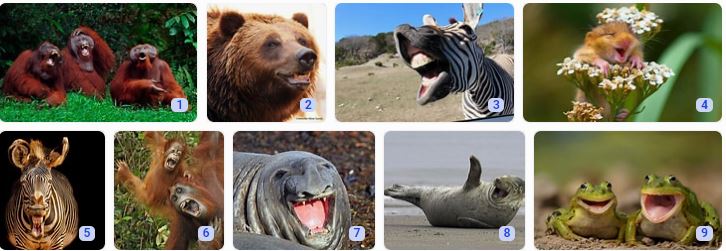Laughing Animals: Experience the enchanting world of laughing animals through this captivating article. Discover the unique behaviors and heartwarming moments that bring laughter to the animal kingdom.
Why Do Animals Laugh?
Behind the veil of amusement lies a deeper question,Why do animals laugh? Scientists speculate that laughter in animals may serve as a form of communication, fostering social connections and relieving tension. Observing primates engaging in laughter-like behaviors provides a glimpse into the evolutionary origins of this expression.
Laughing Animals
According to a recent study, there are about 65 animal species that laugh, including primates, rodents, birds, and large mammals. here are a few examples of animals are mentioned that are known to laugh, or make sounds that are similar to laughter. These include:
Chimpanzees. Chimpanzees make a series of high-pitched panting sounds when they are playing or being tickled. These sounds are thought to be a form of laughter, and they are similar to the sounds that human babies make when they laugh.
Spotted hyenas. Spotted hyenas are also known for their “laughing” sounds. These sounds are actually produced when the hyenas exhale forcefully through their noses. The sounds are thought to be a way for hyenas to communicate with each other, and they may also be a way for them to express excitement or dominance.
Dolphins. Dolphins are another animal that is known to make sounds that are similar to laughter. These sounds are often produced when dolphins are playing or socializing. They are thought to be a way for dolphins to communicate with each other and to express happiness or excitement.
Rats. Rats are also capable of making sounds that are similar to laughter. These sounds are produced when rats are tickled or when they are experiencing positive emotions.
Bonobos. Bonobos are closely related to chimpanzees, and they also make sounds that are similar to laughter. These sounds are thought to be a way for bonobos to communicate with each other and to express happiness or excitement.
Kea. Kea are parrots that are native to New Zealand. They are known for their intelligence and their mischievous behavior. Kea have been known to make sounds that are similar to laughter, especially when they are playing or being tickled.
Australian magpie. Australian magpies are also known for their loud and raucous calls. These calls can sound like laughter, especially when the magpies are excited or agitated.
It is important to note that the sounds that these animals make are not exactly the same as human laughter. However, they are similar enough that they have been described as “laughing” sounds. The exact reason why these animals make these sounds is not fully understood, but it is thought to be a way for them to communicate with each other and to express positive emotions.
Importance of Laughing Animals
Laughing animals are important for a number of reasons.
They help us to understand the evolution of laughter. Laughter is a complex behavior, and it is thought to have evolved independently in a number of different animal species. By studying laughing animals, scientists can learn more about the origins and functions of laughter.
They provide us with insights into animal behavior and cognition. Laughing animals are often highly intelligent and social animals. By studying their laughter, scientists can learn more about their communication patterns, social interactions, and play behavior.
They remind us that animals are sentient beings capable of experiencing a wide range of emotions, including joy and amusement.
In addition to these scientific benefits, laughing animals can also bring us joy and laughter. Watching animals play and have fun can be a very rewarding experience. It can also help us to relax and de-stress.
Studies of chimpanzees have shown that laughter is associated with positive social interactions, such as play and grooming. This suggests that laughter may play an important role in strengthening social bonds and promoting cooperation.
A study of rats found that laughter was associated with a decrease in stress hormones. This suggests that laughter may have health benefits for animals, just as it does for humans.
A study of dolphins found that they use laughter to communicate with each other. This suggests that laughter is a complex and versatile form of communication for animals.
Overall, laughing animals are important because they help us to understand the evolution of laughter, animal behavior and cognition, and the sentience of animals. They can also bring us joy and laughter.
Frequently Asked Questions (FAQs)
1. Can animals genuinely experience joy?
Absolutely. Studies show that animals exhibit behaviors indicative of joy, such as playfulness, social interactions, and laughter-like vocalizations.
2. Which animal’s laughter resembles human laughter the most?
Bonobos, our closest relatives, possess laughter-like behaviors that share similarities with human laughter. Their vocalizations are characterized by short, panting sounds during play.
3. Do animals use laughter for communication?
Yes, laughter-like sounds often serve as a means of communication among animals, signaling playfulness, bonding, and relaxation.
4. How does animal laughter affect their well-being?
Laughter-like behaviors in animals are linked to reduced stress and enhanced social connections, contributing to their overall well-being.
5. Are there any documented cases of cross-species laughter?
Yes, instances of animals engaging in playful interactions with humans or other species have been observed, revealing the universal language of laughter.
6. Can animals distinguish between genuine laughter and imitation?
Research indicates that animals are capable of discerning between authentic laughter and imitation, showcasing their perceptual abilities.






